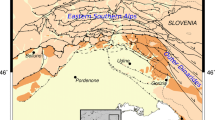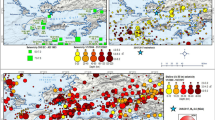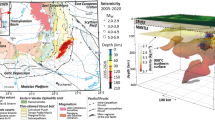Abstract
Analyzing the partitioning of stress and deformation in active orogenic settings is of fundamental importance for understanding the mechanisms driving the geodynamic evolution and seismicity, particularly in complex orogenic settings. In this respect, a quantitative understanding is obtained by coupling the large-scale geodynamic evolution with partitioning of local deformation and stress patterns derived from analyzing the seismicity character, focal plane solutions and kinematics of genetically related active structures. The goal of the present paper is to investigate the stress field characteristics in relation with the specific geotectonics and seismogenic zones of Romania. The principal stress components are computed by inverting the fault plane solutions provided by a completed and updated catalogue for the crustal earthquakes recorded since 1929 up to 2012. Our investigation is justified to the extent that the basic hypothesis of properly representing the seismic area partitioning by individual clusters of events is relevant at the scale of each earthquake-prone area and from statistical point of view (minimum 20–30 events). The catalogue covers mostly the area in front of the Carpathians Arc: Moesian Platform, Barlad Depression, North Dobrogean Orogen, Southern Carpathians belt (Făgăraş-Câmpulung, Central Southern Carpathian and Danubian seismogenic zones) and western part of Romania (Banat region). The seismicity is sporadic and the available fault plane solutions are less representative for the entire area in the inner side of the Carpathians and for the Dobrogea region, located between Danube river and Black Sea. Therefore, for these last two regions the resulted stress field properties are considered as preliminary. The formal stress inversion applied on groups of focal mechanisms proved to be a better estimation of the tectonic stress orientation that can be achieved in the study region in comparison with single focal mechanism, as shown in the World Stress Map Project 2016.




Similar content being viewed by others
References
Bala A, Toma-Danila D, Radulian M (2019) Focal mechanisms in Romania: statistical features representative for earthquake-prone areas and spatial correlations with tectonic provinces. Acta Geod Geophys 54:263–286
Barth A, Reinecker J, Heidbach O (2008) Stress derivation from earthquake focal mechanisms. World Stress Map Project
Bott MHP (1959) The mechanics of oblique-slip faulting. Geol Mag 96:109–117
Carbunar OF, Radulian M (2011) Geometrical constraints for the configuration of the Vrancea (Romania) intermediate-depth seismicity nest. J Seismolog 15:579–598
Delvaux D, Moeys R, Stapel G, Petit C, Levi K, Miroshnich K, Ruzhich V, Sankov V (1997) Paleostress reconstructions and geodynamics of the Baikal region, Central Asia, Part 2. Cenozoic rifting. Tectonophysics 282:1–38
Fojtíková L, Vavryčuk V (2018) Tectonic stress regime in the 2003–2004 and 2012–2015 earthquake swarms in the Ubaye Valley, French Alps. Pure Appl Geophys 175:1997–2008
Heidbach O, Reinecker J, Tingay M, Muller B, Sperner B, Fuchs K, Wenzel F (2007a) Plate boundary forces are not enough: second- and third-order stress patterns highlighted in the World Stress Map database. Tectonics 26:6014. https://doi.org/10.1029/2007tc002133
Heidbach O, Ledermann P, Kurfeß D, Peters G, Buchmann T, Matenco L, Negut M, Sperner B, Müller B, Nuckelt A, Schmitt G (2007b) Attached or not attached: Slab dynamics beneath Vrancea, Romania. In: International symposium on strong Vrancea earthquakes and risk mitigation Oct. 4–6, 2007, Bucharest, Romania, 2007, 3–20, Ed. MATRIX ROM, Bucharest. http://digbib.ubka.uni-karlsruhe.de/volltexte/beilagen/1/proceedings/
Heidbach O, Custodio S, Kingdon A, Mariucci MT, Montone P, Müller B, Pierdominici S, Rajabi M, Reinecker J, Reiter K, Tingay M, Williams J, Ziegler M (2016) Stress map of the Mediterranean and Central Europe. GFZ Data Serv. https://doi.org/10.5880/WSM.Europe2016
Hippolyte J-C (2002) Geodynamics of Dobrogea (Romania): new constraints on the evolution of the Tornquist—Teisseyre Line, the Black Sea and the Carpathians. Tectonophysics 357:33–53
Hippolyte J-C, Sandulescu M, Badescu DN, Badescu L (1996) L’activite d’un segmant de la ligne Tornquist—Teisseyre depuis le Jurassique superieur: la faille de Peceneaga—Camena Roumanie). C R Acad Sci Paris 323(ser. II):1043–1050
Ismail-Zadeh A, Maţenco L, Radulian M, Cloetingh S, Panza GF (2012) Geodynamics and intermediate-depth seismicity in Vrancea (The South-Eastern Carpathians): current state-of-the art. Tectonophyiscs 530–531:50–79
Lund B, Slunga R (1999) Stress tensor inversion using detailed microearthquake information and stability constraints: application to Olfus in southwest Iceland. J Geophys Res 104(B7):14947–14964
Lund B, Townend J (2007) Calculating horizontal stress orientations with full or partial knowledge of the tectonic stress tensor. Geophys J Int 170:1328–1335
Malita Z, Radulescu F (2010) Focal mechanisms of some crustal earthquakes that occurred in the Pannonian depression (Arad– south Timisoara area), the Moesian platform and North Dobrogean Orogen. Rev Roum de Geophys 54:19–37
Martínez-Garzón P, Bohnhoff M, Kwiatek G, Dresesn G (2013) Stress tensor changes related to fluid injection at The Geysers geothermal field, California. Geophys Res Lett 118:2596–2601. https://doi.org/10.1002/grl.504328
Michael AJ (1984) Determination of stress from slip data: faults and folds. J Geophys Res 89:11.517–11.526
Müller B, Wehrle V, Hettel S, Sperner B, Fuchs F (2003) A new method for smoothing oriented data and its application to stress data. In: Fracture and in-situ stress characterization of hydrocarbon reservoirs, Spec. Publ. Ser., vol. 209, edited by M. Ameen, pp 107–126, 2003, Geol. Soc., London
Oros E, Popa M, Moldovan IA, Popescu E (2008) Seismological database for Banat seismic region (Romania)—Part 2: the Catalogue of the Focal Mechanism Solutions. Romanian J Phys 53:965–977
Radulian M, Mandrescu N, Popescu E, Utale A, Panza GF (2000) Characterization of Romanian seismic zones. In: Panza GF, Radulian M, Trifu CI (eds) Seismic Hazard of the Circum-Pannonian Region, Pure Appl. Geophys., 157, 57–77
Radulian M, Bonjer K-P, Popa M, Popescu E (2007) Seismicity patterns in SE Carpathians at crustal and subcrustal domains: tectonic and geodynamic implications. In: International symposium on strong Vrancea earthquakes and risk mitigation Oct. 4–6, 2007, Bucharest, Romania, 93-102, Ed. MATRIX ROM, Bucharest
Radulian M, Bala A, Popescu E, Toma-Danila D (2018) Earthquake mechanism and characterization of seismogenic zones in south-eastern part of Romania. Ann Geophys 61(1):SE108. https://doi.org/10.4401/ag-7443
Radulian M, Bala A, Ardeleanu L, Toma-Danila D, Petrescu L, Popescu E (2019) Revised catalogue of earthquake mechanisms for the events occurred in Romania until the end of twentieth century: rEFMC. Acta Geod Geoph 54:3–18
Raileanu V, Bala A, Dinu C, Radulian M, Popescu E, Diaconescu V, Mateciuc D, Popa M (2007) Crustal seismicity and deep structure in the SE Carpathians and its foreland. In: International symposium on strong Vrancea earthquakes and risk mitigation Oct. 4–6, 2007, Bucharest, Romania, pp 86–89, http://digbib.ubka.uni-karlsruhe.de/volltexte/beilagen/1/proceedings/
Raileanu V, Dinu C, Ardeleanu L, Diaconescu M, Popescu E, Bala A (2009) Crustal seismicity and associated fault systems in Romania. In: Proceedings of the 27-th ECGS workshop: seismicity patterns in the Euro-Med Region, in Cahiers du Centre Européen de Géodynamique et de Sismologie, pp 153–160
Săndulescu M (1984) Geotectonics of Romania (in Romanian), Ed. Tehnică, Bucharest, Romania, 1984, p 334
Tondi R, Achauer U, Landes M, Davi R, Besutiu L (2009) Unveiling seismic and density structure beneath the Vrancea seismogenic zone (Romania). J Geophys Res 114:B11307. https://doi.org/10.1029/2008JB005992
Vavryčuk V (2014) Iterative joint inversion for stress and fault orientations from focal mechanisms. Geophys J Int 199:69–77
Vavryčuk V (2015) Moment tensor decompositions revisited. J Seismol 19(1):231–252
WSM World Stress Map, Scientific Technical Report 16-01 (2016)
Zoback ML (1992) First and second order patterns of stress in the lithosphere: the World Stress Map Project. J Geophys Res 97:11703–11728
Acknowledgements
The authors wish to thank to dr. Oliver Heidbach which gives a considerable help in assembling the Fig. 4 with the setting of the regional stress field in Romania and the background after WSM 2016. The work in this paper was realized in the frame of NUCLEU Program, Projects No. PN 18 15 01 01/2018. We would like to thank the careful and constructive review by prof. Alik Ismail-Zadeh through which the paper gained in value.
Author information
Authors and Affiliations
Corresponding author
Rights and permissions
About this article
Cite this article
Bala, A., Radulian, M. & Toma-Danila, D. Crustal stress partitioning in the complex seismic active areas of Romania. Acta Geod Geophys 55, 389–403 (2020). https://doi.org/10.1007/s40328-020-00299-0
Received:
Accepted:
Published:
Issue Date:
DOI: https://doi.org/10.1007/s40328-020-00299-0




